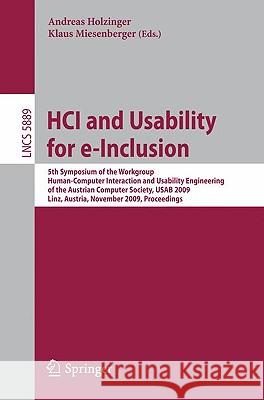HCI and Usability for e-Inclusion » książka
HCI and Usability for e-Inclusion
ISBN-13: 9783642103070 / Angielski / Miękka / 2009 / 576 str.
The Workgroup Human-Computer Interaction & Usability Engineering (Arbeitskreis HCI&UE) of the Austrian Computer Society (Osterreichische Computer Gesellschaft, OCG) has been serving as a platform for interdisciplinary exchange, research and development since February 2005. While human-computer interaction (HCI) tra- tionally brings psychologists and computer scientists together, the inclusion of usab- ity engineering (UE), which is a software engineering discipline and ensures the appropriate implementation of applications, has become indispensable. Our 2009 topic was therefore Human-Computer Interaction & Usability for e- Inclusion (HCI4e-I), culminating in the 5th annual Usability Symposium USAB 2009 held during November 9-10, 2009 in Linz, Austria (http: //usab.icchp.org), organized together with the Workgroup Information Technology for People with Special Needs (OCG Arbeitskreis IT fur Menschen mit besonderen Bedurfnissen). The term e-inclusion, also known as digital inclusion, is used within the European Union to encompass all activities related to the achievement of an inclusive infor- tion society. New information technologies always bring the risk of a digital divide, and con- quently e-Inclusion wants to put emphasis on a digital cohesion and on enhancing opportunities with IT into all segments of the European population, including dis- vantaged people, e.g., due to lack of education (e-Competences, e-Learning), age (e-Ageing), gender apartheid (equality=e-Quality), disabilities (e-Accessibility), ill health (e-Health) etc. At the European level, e-Inclusion is part of the third pillar of the 2010 policy initiative, managed by the Directorate General for Information Society and Media of the European Commission.











